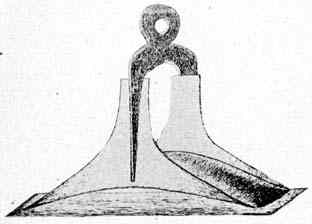|
36
|
SEMI-CENTENNIAL HISTORY OF
NEBRASKA
|
|

Ancient Spanish Stirrup, Found in Franklin County
Under Four Feet of Soil in 1872. Property of
Hugh Lamaster, Tecumseh
great nations, living in this region--the
Gnasticares, the Mozamleek and the Tamuglauk. Some of
them wore beards a foot long. There were ships with 200
oarsmen, houses built of stone, forts and palaces. When
an Indian was about to die friends gathered around to
catch his spirit as it left the body,--from which La
Hontan concluded they were Pythagoreans and believed in
the transmigration of souls. The extraordinary industry
and ingenuity of La Hontan is shown by a long vocabulary
of Indian words with their French equivalents. Many of
the customs, animals and plants are given by him
correctly, but as a whole his work is a mass of
fabrication rivalling (sic) Gulliver's Travels.
The period of the real
explorer of Nebraska was at hand when La Hontan printed
his book. As early as 1700 the French archives begin to
contain reports of Canadian voyageurs who had gone into
the Missouri country. On Nov. 16, 1705, two canoes of
voyageurs came to the Illinois settlements. In one of
them was a Frenchman named Laurain who had been in the
Missouri river valley and brought vague news of the
Indians who dwelt there and of the Spanish provinces
beyond. In 1708 Nicolas de La Salle, brother of the great
discoverer, met French trappers who had been up the
Missouri seven or eight hundred miles. They said it was
the most beautiful country in the world, with herds of
wild cattle beyond power of the imagination to conceive,
with mines of copper and iron and other metals. Again in
1717 numerous trappers coming down the Missouri declared
that the climate was the best in all the French colonies,
that the country was rich and that trees of all kinds
grew, wild cattle, deer and goats were abundant and there
was great plenty of salt although it was so far from the
sea. This hints strongly of central Kansas or eastern
Nebraska. In 1719 an expedition under command of Du Tisne
came up the Missouri, camped at the Osage village and
from there went westward until he reached the Pawnees.
The next year French voyageurs brought the news that an
army of two hundred Spanish cavalry, accompanied by a
large force of Comanches, invaded the Pawnee country but
were surprised by a large war party of Otoes and Pawnees
and entirely defeated. This story of war between Nebraska
Indians and the Spanish is repeated so many times by the
Frenchmen who came down the Missouri that it seems as
though it must have adequate foundation. The same
travelers, however, repeat over and over the story of
valuable mines along the Missouri from which the
Spaniards carry mule loads of different metals. Finally
in 1724 M. Bourgmont establishes a French fort in what is
now the state of Missouri about ninety miles below Kansas
City. His reports are full of interest and show that he
knew correctly the location of the Otoes, the Pawnees,
the Omahas and the Aricaras; he describes the
|




